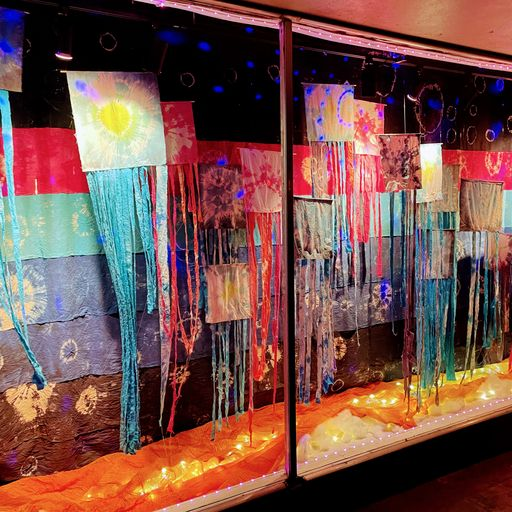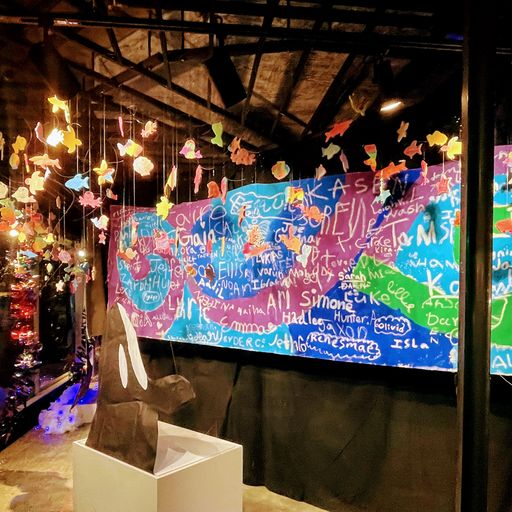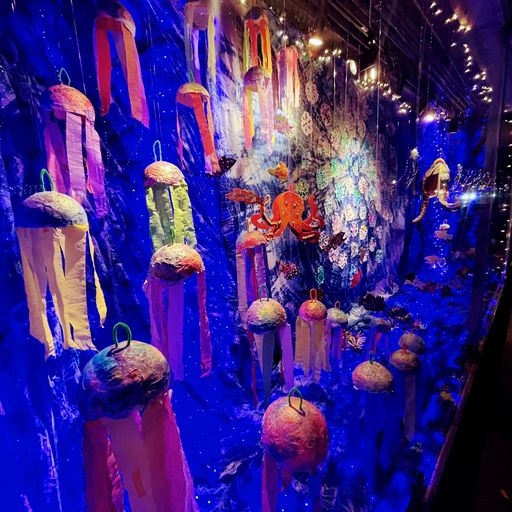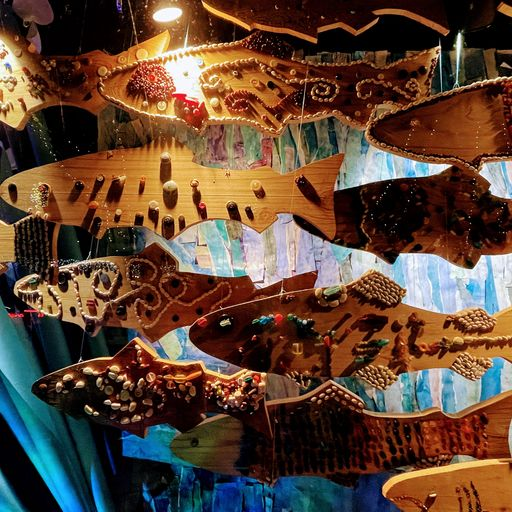by Alec Clayton
The storefront windows at the Goldberg Building on the corner of Capital and 4th Avenue sparkle with artistic depictions of sea life created by local students from Fine Arts Club at South Sound Dance, Hansen Elementary School, Olympia Waldorf School and Madison Elementary under the direction of local educators and artists Cyrra Robinson, Lindsey Johnstone, Ali Carras and Graeme Smith.
The exhibition, a project of Olympia Artspace Alliance in partnership with local projects including the Art in Olympia Storefronts project, Artists on Board, and through other collaborations and the City of Olympia, is called “Winter—Under the Salish Sea.” It will remain in place through January and February to brighten our winter days as we slowly swim toward the bright sun of spring and summer. It is a stylized and festive installation.

Walking past it from Capital and around the corner to 4th Avenue gives one the feeling of being in an aquarium.
First seen in the Capitol Way windows, “Jelly Town” is a sea of tie-dye cloth jellyfish by Madison Elementary students directed by Graeme Smith. The jellyfish are made of square sheets of painted paper with papers streamers hanging down with the appearance of perpetual motion.
Smith explained, “(The installation) contains dyed fabric jellyfish combined with lights and fans to add movement. We figured out how to rubber band the pieces of fabric to look like the four different jellyfish we were trying to represent. Students then each made their own jellyfish designs with rubber bands and proceeded to dye the jellyfish the following week. We used the vat dyeing method where the fabric is soaked in soda ash and then dunked in a bucket of dye and water. This process is inspired by indigo dying and is a way to dye large amounts of fabric at once. Using plastic gloves and tongs, students transferred their jellyfish from the soda ash to one of the different colored dye buckets. The students that made the fried egg jellyfish used a slightly different process because the center is a different color than the outside. They used a squeeze bottle to apply yellow tie dye to the center of their jellyfish and then used a rubber band to fasten a plastic bag over the center. They then transferred their jellyfish to the dye bucket to dye the rest. The yellow area that the bag covered was protected from the blue dye in the bucket and it resulted in a beautiful multicolored jellyfish pattern.

“For the second part of the project, students rubber banded and vat dyed the tapestry background and the tentacles. Students used the sunburst dying technique (where you create consecutive circles with rubber bands) to make a fantastical, multicolored background that looks like jellyfish floating up from the water and into the stars. We moved the tables and chairs to the side of the room, laid out the tapestry pieces, and students used liquid stitch to glue the different pieces together. The final step was then adding the tentacles, students tore strips of fabric into long pieces and hot glued them to the bottom of each dyed jellyfish so that the light stringy fabric would move with the fan.”
Finally, Smith said, “The tie dye project was great for students because the process involved mystery and relinquishing control to the process. Students sometimes get frustrated with their art not looking how they wanted it too. With tie dying, it almost never turns out how they want it to look and they love it.”
In the next window is “Winter Under the Salish Sea” by Hansen Elementary students directed by Lindsey Johnston. It rounds the corner onto the 4th Avenue window and presents a virtual wall of kelp or seaweed made of paper chains.

“Dancing in the Salish Sea” by the Fine Arts Club at South Sound Dance with teacher Cyrra Robinson has a blue cloth floor and tie dye cloth backdrop, with painted paper fish, a strange octopus, and jellyfish. Robinson said, “‘Dancing in the Salish Sea’ was created by 29 student artists from three classes (3-5 years of age). In Fine Arts Club we often dance like creatures that live in the ocean or sing about animals in the sea, so naturally we decided on creating an installation filled with sea creatures that are joyfully dancing together in the South Puget Sound. Each student worked on an individual project where they painted and experimented with a variety of repurposed materials to bring hand-cut cardboard fish to life. Younger children sculpted colorful jellyfish using paper mache and streamers while older students created a cardboard sea animal that inspired them. The oldest group of students worked together to make a large wiggly octopus out of repurposed materials.
“Each class discussed what made their chosen sea creature unique and how their diverse characteristics benefited the individual animals as well as how they help the larger ecosystem function as a whole. A jellyfish gracefully sways effortlessly in the Salish Sea, a pod of orca whales work together to choreograph a collective charge on their prey, and a school of fish synchronistically swim to survive. This installation serves as a celebratory dance honoring self-expression, biodiversity, and communal belonging.”

Finally, “The Courage of the Salmon” by Olympia Waldorf students with Ali Carras consists of cutout and painted wood salmon with plaster barnacles and jellyfish and starfish. Carras said, “‘The Courage of the Salmon’ is an underwater representation of our students and their developmental stages. The barnacles symbolize the young early childhood students who are still tightly attached to their grown-ups. The jellyfish represent the amorphous kindergartners who are figuring out their bodies while under immense amount of growth and change. The sea stars symbolize those who are starting to stretch their minds and independence. The swimming salmon are growing stronger and more courageous as they begin to experience the journey and challenges of life ahead. And the plant life keeps everything in the water alive and healthy.
“Our preschoolers made the barnacles out of salt dough. The Kindergartners felted some of the jellyfish. The 1st graders used their handwork skills to sew the sea stars. Our 2nd through 4th grade made the salmon. We aimed to use materials that respect Native tradition, so the wood is cedar and the fish are decorated in buttons, glass beads, purple corn kernels and beans. Our 5th graders do a botany block, so it is appropriate that they made the seaweed. Our middle schoolers are the life of the school and they created all the background elements.”
Approximately 280 students worked on the project.
About Olympia Artspace Alliance
Olympia Artspace Alliance’s mission is to preserve, develop, and advocate for affordable live, work and exhibition space for artists in Olympia. OAA’s work on behalf of artists of all artistic expression is guided by these core values: community, Inclusion, advocacy, affordability, trustworthiness and creativity.
WHAT:
WinterFest 2022 Art in Storefronts
WHERE:
Windows of the Goldberg Building, 403 Capitol Way S., at the corner of Capitol Way and 4th Avenue, Olympia
WHEN:
Continuing through February 2023.
LEARN MORE:
https://www.olympiaartspace.org/
Photos courtesy of Olympia Artspace Alliance.
